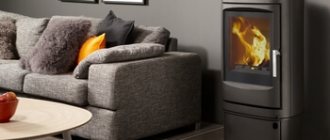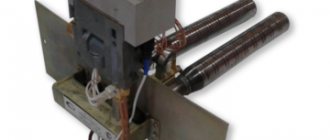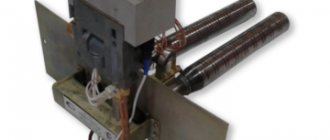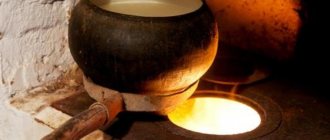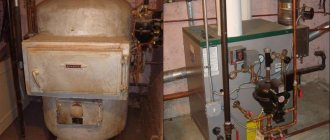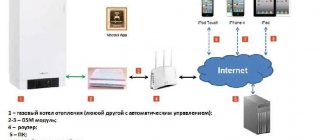It has long been known that ignition from above on different fireboxes - heating stoves, fireplaces, sauna stoves with different chimney heights allows you to get a 100% result, which many people like: it’s easy and quick to get smoke and fire, the firewood sets, no smoke comes into the room, and glass (if it is included in the design) does not smoke, the chimney warms up quickly, and there is no condensation. Ignition from above has been known for a long time. For example, the same candle or match, not to mention the Mayan tribes, who erected pillars, cut them a little on top and set them on fire, and these lanterns burned for a long time and brightly.
When igniting from above, the wood burns more slowly, since only the top part of the stack burns. With bottom ignition, the entire volume burns from bottom to top faster, which is why this method is in demand. In order for the entire stack to burn during top ignition, it is necessary to establish air flow, organize it from the ignition side and so that it passes through the entire thickness of the firewood or coal stack, in which case the flame will engulf the entire firebox, and not just some part of it.
In fact, normal manufacturers practice just this method. The air is preheated and thrown from above. For example, the manufacturer of Keddy fireplace stoves with air supply throughout the entire plane.
Design features and operating principle
Long-burning top-loading boiler - diagram
The internal part is used as a firebox. It is designed so that combustion occurs from top to bottom. This is helped by a special air supply directly to the combustion zone. The process is more reminiscent of smoldering with the production of gases from carbon-containing fuel. To a large extent, these gases are flammable. Due to their combustion in the upper part of the firebox, maximum use of thermal energy occurs, which allows increasing heat transfer and reducing fuel consumption.
The boiler chamber is divided into two parts by an air distributor. It has the shape of a pipe, to which a platform with blades is attached at one end, and the other end serves to supply oxygen.
Boilers with top combustion are characterized by cyclical operation, and until the first fill burns out, adding a second batch of fuel will not be necessary.
Let's start making - what you need
To make a homemade stove, you need to choose a convenient place. This must be a room with connected electricity and sufficient area. Now about the materials. It is easier to use a 200 liter steel barrel for a stove with a long burning time. However, the volume is not of fundamental importance; the heat transfer of the device will simply depend on it. They use gas cylinders and even fire extinguishers.
The stove can be made from an old gas cylinder
But, again, the volume of the workpiece: from a 27 liter cylinder you can make a stove for heating a bathhouse, from a smaller one or a fire extinguisher - for a tiny room. The thickness of the metal matters: the thicker it is, the longer the stove will last. If there is nothing suitable, we use a thick-walled pipe or steel sheets. The metal must be free of damage and rust. Other materials you will need:
- material for the legs if the oven is round in shape (pipes, angle, fittings);
- sheet steel 5 mm thick according to the dimensions of the end side of the product;
- sealed door or material for it;
- The 100 mm pipe is 15 cm longer than the device;
- 5 m of 150 mm pipe for smoke removal.
Measuring instruments are required: tape measure, plumb line, level, as well as a hammer, mallet, trowel.
Technical characteristics of top combustion boilers using solid fuel
Top combustion boilers are produced with different powers from 8 to 95 kW. Some models can reach 1200 kW. The higher the indicator, the more efficient the unit’s operation and the larger the area that can be heated. Boilers with minimum power are designed for installation in small houses. Ukrainian "Burans" with 40 kW are intended for heating large houses or warehouses.
Solid fuel boiler BURAN-EXTRA 1200
Boiler manufacturing materials are cast iron or steel. A cast iron heat exchanger is more durable, but due to its heavy weight it can cause installation difficulties. Steel heat exchangers are made from steel of various qualities, from low-grade to high-quality, resistant to high temperatures. In addition, steel boilers are often protected by fireclay bricks.
Most often, top-burning boilers operate on wood, but there are models in which coal, peat briquettes, shavings and other fuel can be placed.
The boiler efficiency is 85-93%. According to the manufacturers, the operating time of the device after one load of firewood ranges from 8 to 31 hours, and on coals up to 5 days. The average inexpensive boiler produces heat within 5-8 hours.
The water heating temperature is 70 0C for wood and 85 0C for coal. Recommended inlet temperature from 60 0C. The heating system can be either natural or forced circulation.
Installing a heating device - important rules
For the installation to operate safely, certain rules must be followed:
- It is prohibited to place combustible and flammable objects within the warming-up distance;
- we make the chimney dismountable for cleaning;
- Before use, we carry out a test to select the optimal mode.
The diameter of the chimney exhaust pipe is about 15 cm.
For the chimney exhaust we use a pipe with a diameter of 150 mm and a length of 5 m. With a smaller cross-section, smoke will not be removed well; with a larger cross-section, excess draft will appear. We install an adjustable damper on the chimney. Accumulated condensate must be removed periodically. If the chimney is not dismountable, doors are made in it for cleaning. Excessive formation of condensation can be prevented by constructing a chimney using the sandwich principle. Between two pipes of different diameters we place a layer of glass wool for insulation. We cover the top of the chimney pipe with a deflector to prevent rain, snow, and wind from blowing in.
In a house where there are children, we line the stove with bricks. The masonry around plays the role of a protective screen, so as not to get burned if you accidentally touch it, and protects objects and walls from overheating. It also serves as a good heat accumulator. The brick will accumulate heat and release it much more slowly than the iron body. We arrange the foundation if the floor under the stove is made of flammable materials. It is not necessary to deepen it too much; the weight of the heating device is light.
Advantages and disadvantages of solid fuel top combustion boilers
Top combustion boilers have been providing heat to users for over 15 years. During this time, they have fully confirmed their effectiveness, which is ensured by the following factors:
- when fuel is added, the distributor rises up, and after ignition it rests on the firewood and lowers as it burns out;
- at the point of air entry, incomplete oxidation of hydrocarbons occurs. Gas with ash particles is transferred to the upper part of the combustion chamber. There oxygen joins it, as a result of which it burns out and gives off the remaining heat;
- At the beginning of the gas combustion chamber, there is a draft regulator. With its help, the water temperature is automatically determined and the combustion rate of volatile compounds is adjusted.
The boilers have the following advantages:
- long operating time and minimal number of downloads;
- energy independence due to working with natural circulation and natural traction;
- the versatility of some units in terms of fuel: coal, firewood, shavings, peat, etc.;
- a small amount of fuel can ensure high operating efficiency;
- automated continuous operation of the boiler to supply hot water and heat;
- the absence of complex mechanisms makes operating the boiler simple even for beginners;
- high level of security;
- long service life of 10-15 years or more.
A top-burning boiler has a high level of safety.
Disadvantages of solid fuel boilers with top loading:
- high cost compared to other installations;
- sensitivity to changes in heat exchanger temperature. Possible condensation and oxidation of steel elements;
- increased ash content can clog the combustion zone and reduce the level of heat transfer;
- it is necessary to manually clean the chimney and ash pan regularly;
- inconvenient stacking of firewood due to design features;
- Do not load large quantities of fuel, for example, unchopped firewood;
- the fuel must be completely dry, so you need to consider the conditions for its storage;
- incomplete loading makes ignition inconvenient, because the firebox is deep enough;
- You cannot reload if the process is already running;
- the support beam and disk, which serve as a partition between the combustion zones of solid fuel and gas, quickly fail.
As you can see, top-burning solid fuel boilers are not without their drawbacks, so before purchasing such a device, carefully weigh the pros and cons.
Test results of the prototype:
- stove without an outer convector body - hot body diameter = 300 mm, height = 780 mm - hopper diameter = 200 mm, height = 800 mm - distance from the bottom of the firebox to the cut of the hopper = 200 mm - thin-walled chimney, steel, uninsulated, D = 115 mm - poorly insulated production room with a volume = 175 cubic meters - outside temperature = - 10 degrees. WITH
Test No. 1
1. Firewood - 9 kg, mixture of coniferous and birch firewood, relative humidity = 20%
2. Combination mode: medium/low.
3. Burning time = 6 hours.
4. Increase in temperature at the end of the fire from 0 to +6
5. Ash = 150 g (1.6%)
Test No. 2
1. Firewood - 12 kg, mixture of coniferous and birch firewood, relative humidity = 20%
2. Combination combustion mode: strong / medium.
3. Burning time = 4 hours.
4. Temperature increase from -2 to +8 5. Ash = 200 g (1.6%)
Test #3
1. Pellets (light) - 15 kg,
2. Combustion mode: weak.
3. Burning time = 8 hours.
4. Temperature increase from 0 to +8
5. Ash = 100 g (0.7%)
Test No. 4
1. Pellets (light) - 15 kg,
2. Combination combustion mode: strong / medium.
3. Burning time = 4 hours.
4. Temperature increase from 0 to +12
5. Ash = 100 g (0.7%)
Nuances of the top combustion boiler control system
In long-burning boilers with top combustion, the main control principle is the regulation of air flows entering the combustion chamber. Standard units are equipped with a mechanical device for this purpose. The chain driven damper is driven by the thermostat.
The thermostat in the boiler is adjusted to a certain temperature. When the coolant heats up to the desired level, the damper is automatically set to a certain position, reducing the heating intensity. It is impossible to sharply reduce the temperature, because... The coolant will continue to heat up by inertia, heating the room.
It is also impossible to increase the water temperature whenever you want. Until the boiler “accelerates”, the temperature will rise very slowly.
Devices with fans work a little differently. If you need to increase the heat transfer force, this can be done using a fan. The device will pump air. Due to this, it is also possible to reduce the inertia of the boiler. Control occurs automatically, and sensors record the slightest changes in coolant temperature.
DIY pyrolysis rocket stove made from cans
A camping wood chip burner will always come in handy, especially since it does not require special materials or skills. Even a teenager can make it. However, for those who first tackled the issue of heating with “rocket” stoves, this will be good practice, since the operating principle is identical:
- We take two tin cans of different diameters and heights (the difference is 20–25 mm).
- Cut a hole equal to the diameter of the smaller can in the bottom of the larger can.
- We make a network of holes in the bottom of the smaller jar.
- We make a belt of holes on the wall of the smaller can at 1/5 of its height from the open edge.
- We make a belt of holes on the wall of the larger can at 1/7 of the height of its open edge.
- We insert the smaller jar into the bottom of the larger one so that the bottom of the smaller one fits the open edge of the larger one. The burner is ready.
You probably already guessed that, in principle, this is a coaxial gas pipeline system. By adding various accessories to such a burner, you can increase the volume of the fuel compartment or boil water.
If you cut a hole in the wall of a larger container and install a fan, you will get nothing more than a turbocharged RP.
Using this “pocket” option, you can conduct experiments and comparative measurements - how the material burns by itself and how it burns using secondary air.
Review of the best top combustion boilers
Currently, the production of solid fuel boilers has expanded significantly and consumers have a choice of many models from foreign and domestic companies. Let's look at the best of them.
Stropuva
Stropuva
Boilers from the Bulgarian company Stropuva are compact units with high efficiency. The devices are equipped with a blower fan. The cylindrical body has a shaft design. The devices are distinguished by excellent performance characteristics combined with excellent design. Universal boilers can be heated with wood, peat or pressed briquettes. Model power 8-40 kW, heated area 30-400 sq.m. The permissible fuel moisture content can reach 45%, which fully meets modern requirements.
Liepsnele
Liepsnele top-burning boilers
In Lithuania, long-burning solid fuel boilers of a universal type are manufactured, i.e., operating on any type of fuel. The power of the units varies in the range of 10-40 kW, the heated area is up to 400 sq.m. The maximum operating time on one stack of coal is up to 7 days, firewood - up to 2 days. The design of the boilers is a classic shaft type with top combustion. Liepsnele boilers have high efficiency, at least 90%, regardless of the type of fuel and the choice of operating mode.
A week
Model range of Nedelka boilers
The boilers are rectangular in shape, have an attractive design and compact dimensions. For more complete heat removal, channels are provided through which heated flue gases pass. Russian top-burning boilers, capable of operating on one load of coal for up to 7 days.
Boiler week
The Nedelka company offers four variants of boilers with different capacities, providing heating of rooms of different sizes: 50-250 sq.m., 150-400 sq.m., 400-800 sq.m., 800-2000 sq.m.
How does a rocket stove work?
Despite the loud space name, this heating structure has nothing to do with rocket systems. The only external effect that gives some resemblance is a jet of flame that escapes from the vertical pipe of the camping version of the rocket stove.
The work of this center is based on two basic principles:
- Direct combustion - free flow of fuel gases through the furnace channels without stimulation by the draft created by the chimney.
- Afterburning of flue gases released during wood combustion (pyrolysis).
The simplest jet stove operates on the principle of direct combustion. Its design does not allow achieving thermal decomposition of wood (pyrolysis). To do this, it is necessary to perform a powerful heat-accumulating coating of the outer casing and high-quality thermal insulation of the inner pipe.
Despite this, portable rocket stoves perform their functions well. They do not require much power. The generated heat is quite enough for cooking and heating in the tent.
